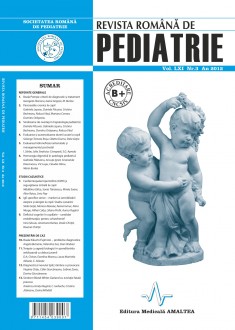SELECT ISSUE

Indexed

| |

|
|
|
| |
|
|
|

|
|
|
|
|
|
|
HIGHLIGHTS
National Awards “Science and Research”
NEW! RJP has announced the annually National Award for "Science and Research" for the best scientific articles published throughout the year in the official journal.
Read the Recommendations for the Conduct, Reporting, Editing, and Publication of Scholarly work in Medical Journals.
The published medical research literature is a global public good. Medical journal editors have a social responsibility to promote global health by publishing, whenever possible, research that furthers health worldwide.
Chronic pancreatitis in children
Gabriela Lesanu, Daniela Pacurar, Cristina Becheanu, Raluca Vlad, Mariana Coman and Dumitru Oraseanu
ABSTRACT
Chronic pancreatitis (CP) is characterised by chronic inflammation, progressive fibrosis, pain and loss of endocrine and exocrine functions. In 1999 the hypothesis of sentinel acute pancreatitis event – SAPE was formulated. This suggests that the initial episode of acute pancreatitis generated by metabolic or oxidative stress is followed by recurrent or chronic inflammation which will finally lead to fibrosis. The pancreatic stellate cells have a key role in the progression of chronic pancreatitis and in the initiation of fibrinogenesis. CP is a heterogenous disese with a clinical picture that includes pain, endocrine and exocrine pancreatic dysfunction and various complications that might implicate adjacent organs. For the diagnosis of CP in adults histological, morphological criteria or a combination of clinical, functional and morphological arguments are needed. Recently the International Study Group Of Pediatric Pancreatitis proposed a set of diagnostic criteria for CP: (a) typical abdominal pain plus characteristic imagistic findings or (b) exocrine pancreatic failure plus imagistic findings or (c) endocrine pancreatic failure plus imagistic findings. The etiology of CP is different in children compared to adult patients. Lately remarkable progress was made in the knowledge of hereditary and autoimmune pancreatitis. Obstructive causes may be identified in CP in children. Chronic obstructive pancreatitis are determined by congenital or acquired mechanical factors. The therapy includes: conservative measures (analgesia, antiinflammatory medication, enzyme substitution), endoscopic interventions and surgical procedures. Endoscopic retrograde cholangiopancreatography is used as therapeutic procedure for biliopancreatic disease with recurrent or chronic pancreatitis. In patients with no response to any of this therapeutic measures total pancreatectomy and self transplantation of pancreatic islets may be tried.
Key words: pancreatitis, pancreatic stellate cells
